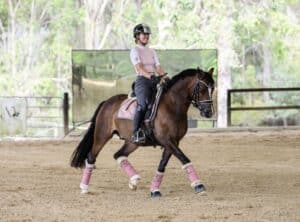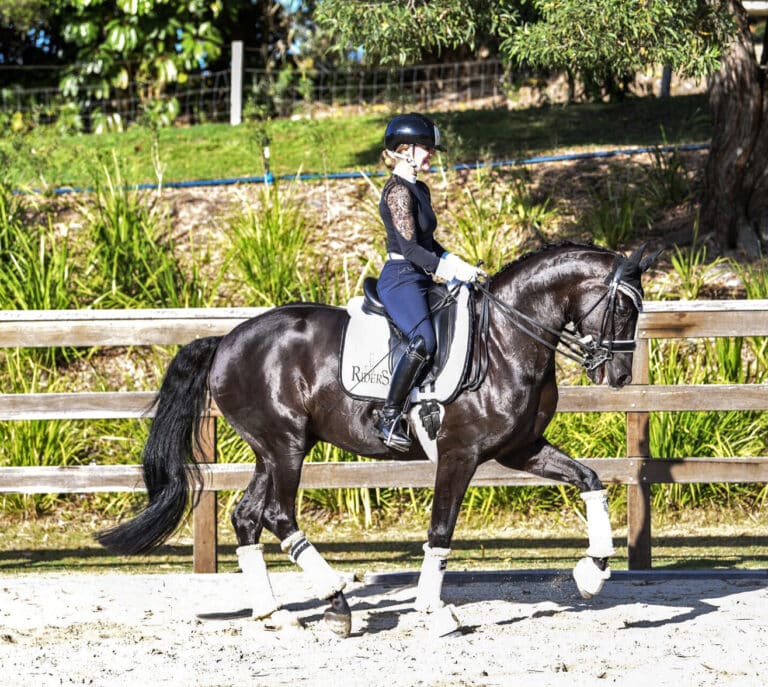It’s all in the transition
Never underestimate the importance of transitions. NICOLE TOUGH explains how to get the best out of each and every one.
In the first year of dressage training, the basic transitions to master include the walk-halt-walk, followed by trot-walk-trot, and then the canter-trot-canter, which is the hardest transition to organise and balance.
Once these transitions are established, we can introduce transitions within the trot and canter paces by lengthening and shortening them. This gradual development of the paces culminates at the Grand Prix level, where we will need multiple gears within the paces: three in walk, six in trot, and five in canter, not to mention all the transitions between the gears.

As we move up the levels, we will also need more difficult transitions, trot-halt-trot, walk-canter-walk, canter-halt-trot, rein-back into trot and canter, passage into canter, and walk into piaffe/passage.
There are two reasons why transitions matter. Firstly, they are the tools for developing the carrying and pushing power that enhance the paces; and secondly, they are judged in competition against the Training Scale, making up a huge part of a final score.
Every good downward transition, even the most basic from trot to walk, trains the horse’s sitting muscles, which are needed for engagement and for improving carrying capacity – so that one day they can carry out canter pirouettes and piaffe. Meanwhile every good upward transition, even the most basic from walk-trot, trains the horse’s pushing muscles, which are needed for forward thrust – so that one day they can carry out extended trot and passage. The more engagement we achieve, the more push we achieve, and that results in increased impulsion. As trainers, we want to train both sets of muscles – the carrying and the pushing – to develop impulsion. Adding impulsion (time in the air) is the game changer in dressage training. In essence, the transitions are gym machines, and our means of developing our horse’s strength.
With all transitions the key word is ‘good’. Because our aim is to develop muscle memory, only good transitions count in terms of training the muscular development of our horses.
If we, as the horse’s personal trainer, accept a transition where something went wrong (perhaps they leant on the bit, hollowed in the back, hesitated, shuffled before the transition, stepped to the side, swung the quarters and so on), then we have allowed our horse to step off the gym machine and we have failed in our task of training the horse’s muscles so they are able to score well at our current level or progress to Grand Prix.
Instead, we should aim to achieve what Steffen Peters recommends: to turn every mistake into a training opportunity. But what does this mean?

Every transition has a start, middle and end phase, and the rider should abort in the phase where the mistake occurred. For example, if we start from a walk that is crooked and leaning on the rein for balance, then a transition to trot has no chance of being a success. But if we start from our best walk, the success rate increases.
However, if we start with our best walk but our horse then either takes a few longer steps in walk before they trot; or they lean on the hand; or drop their sternum lifting their neck; or they step sideways to achieve the transition, we should abort in this middle phase. And in the final phase, the first step has to be like the second and the third; if you don’t love the first step of the new gait, start again.
In every transition we must ask ourselves, could we have done it better? And if the answer is yes – do it again, and again, until we’re satisfied that we can’t do it any better today. Horses learn through repetition, and for us to accept is to approve. So, what muscle memories do we want to accept and train? The good, or the not so good?
To successfully train horses, we must learn to think like a horse. Why do they evade? Because going to the gym is hard! All horses like to use their necks to balance when they should use their hindleg; and they use their necks by becoming long in the transitions, thereby evading the sitting and pushing degree of difficulty. If horses can, they will use the transition to train the rider when it should be a partnership where the rider uses the transitions to train the horse. We should aim to compress them in the transition, which will result in thrust.
A horse that is able to maintain compression through transitions is said to be in self-carriage. These horses will have a ‘U’ shape under the gullet, and our goal should be to maintain this in all the work and every transition. Think haunches first rather than nose first in transitions.
A good training session involves hundreds of transitions, from one gait to another as well as transitions within gaits. We should make every transition we ride count.
Horses improve at what they regularly do, so we should endeavour to practise more of what we know to be helpful to their development, and less of what we know is detrimental. The better we get at recognising and correcting evasions in the transitions, the more we develop our equine athlete.



